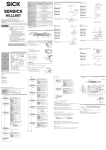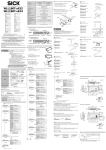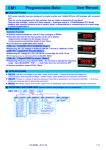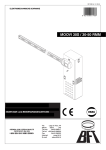Download Herunterladen
Transcript
Modell Standard Leitungs- Basiseinheit typ Erweiterungseinheit WLL190T-2M/L432 M8 3pin Erweiterungseinheit WLL190T-2F/E333 WLL190T-2F/E393 Basiseinheit WLL190T-2M/L434 WLL190T-2M/L494 Erweiterungseinheit WLL190T-2F/E434 WLL190T-2F/E494 Versorgungsspannung erhalten Lichtquelle Betriebsanzeige/ Display Empfindlichkeitseinstellung Schutzkreis Blau 3 Braun 1 4 -25 ...+55 °C/35 ... 85% RF (kein Frost, keine Kondensation) Schutzart IP 54 Gehäusematerial Leitungstyp: 65 g, M8-Typ : 18 g Betriebstemperatur schwankt je nach Anzahl der angeschlossenen Sensoren: 1-3 Geräte: -25 ... + 55 ºC 4-8 Geräte : -25 ... + 50 ºC 9-16 Geräte : -25 ... + 45 ºC (Ausgangsstrom 50 mA) (Ausgangsstrom 20 mA) Load 0V 12~24 V DC Schaltausgang 1 Weiß 2 Blau 3 Schaltausgang 2/ Externer Eingang 0V 12 24 V DC Schaltausgang 2/Externer Eingang 0V Schaltausgang 1 Manuelle Einstellung Im Zonen Teach-in Einstellung der oberen Grenze (Fern) Hauptanzeige Nebenanzeige SET/RUN Auswahl Mode-Schalter Lichtleiter Bitte beachten A Anzeigewert der Hauptanzeige auf „0“ stellen. einstellen. wählen und Die Anzeige kehrt zum Nullwert-Top-Menü zurück. Nullwert- Einstellung ausschalten.1) d I g Numerische Anzeige1) b A r Balken-Anzeige P c t Prozentuale Anzeige Anzeige Gesamtzahl o F F Anzeige inaktiv E r r 3 Weist auf einen Rechenfehler hin. c P L t Weist auf eine Unterbrechung des Teach-in hin. „cnt“ oder „tcnt“ können nur bei eingestellter Zählfunktion gewählt werden. P r c S Eine Erkennungsmethode aus der Liste wählen. einstellen. wählen und Die Anzeige kehrt zum Dynamische Schaltschwelle-Top-Menü zurück. S t n d Die Mode-Taste drücken. S t n d Den Betriebsmodus auswählen. wählen und einstellen. Die Anzeige kehrt zum BetriebseinstellungsTop-Menü zurück. o n ON - dunkelschaltend. L o n g Hochgenaue Einstellung 2 ms S t n d Standardeinstellung 250 μs1) t I E r o F F TOP o F d y o n d y S H o t c n t o F F TOP Schnellste Einstellung 60 μs TOP 5. Detaileinstellungen (Expertenmodus) OFF-Delay I – o ON-Delay TOP One-Shot TOP 0 0 0 1 5.6 Externe Eingangsfunktion t c h 5.7 Kopiermodus c o P Y n o TOP n – – A Q1: Schaltausgang Q2: Alarmausgang Eine Zuweisung des externen Eingangs wählen. einstellen. wählen und Die Anzeige kehrt zum Extern Eingangsfunktion-Top-Menü zurück. t c h Aktiviert Extern-Teach-In. c r S t Setzt den Zähler zurück. Kopiert die Einstellung auf die angeschlossenen Erweiterungseinheiten. einstellen. wählen und Die Anzeige kehrt zum Kopiermodus-TopMenü zurück. Keine Kopierfunktion Kopierfunktion TIPP Die gesperrte Auswerteeinheit wird nicht geändert. 5.8 Displaywerte auf Null setzen. A L Keine Initialisierung 1) 0 TOP Initialisierung 7. Beenden der Einstellung E l t BA_WLL190T_2_bus_de_en.indd 1 Q1 + Q2: Schaltausgang1) Q1: Schaltausgang Q2: Externer Eingang n o Zurück zur normalen Anzeige einstellen. n – – I y E S Initialisiert alle Einstellungen. wählen und einstellen. Die Anzeige kehrt zum zum InitialisierungsTopMenü zurück. y E S SET n o Schalter auf RUN Schaltschwelle SET Die Schaltschwellenanzeige blinkt kurz und das Display zeigt die Grundanzeige. Stellt die Schaltschwelle mit ±5% entsprechend dem empfangenen Licht ein. RUN Setzt den Wert des Hauptdisplays der angeschlossenen Auswerteeinheiten auf 0. einstellen. wählen und Die Anzeige kehrt zum Nullwert-Top-Menü zurück. Führt keine Nullwert-Einstellung n o durch. Führt Nullwert-Einstellung y E s durch. TIPP Die gesperrte Auswerteeinheit wird nicht zurückgestellt. B Der Schwellwert wird auf 90% vom empfangenem Licht eingestellt. Die Schaltschwellenanzeige blinkt und das Display zeigt die Grundanzeige an. Wechsel des Schwellenwerts des Alarmausgangs B Mit der Alarmeinstellung (Alarmausgang im Menü 5.5 Eingangs-/ Ausgangs-Einstellung) kann der Schwellenwert eingestellt werden. 5.9 Master-Teach-in A L t n o TOP Die Basiseinheit führt das Teach-in aller verbundenen Einheiten aus. Die Änderungen sind nur verfügbar bei Transparent Teach-in und ASC-Einstellung auf ON. wählen und einstellen. Die Anzeige kehrt zum Master-Teach-in-Top-Menü zurück. Im Run-Modus, Wechsel zu Q2 durch Drücken von Nachdem Ch2 blinkt, ändert sich die Anzeige. Änderung durch Führt kein Teach-in durch. n o Führt 1-Punkt-Teach-in durch. y E s TIPP 5.10 APC-Einstellung A P c Die gesperrte Auswerteeinheit führt kein Teach-in durch. 5 0 0 Ausgang aktiv im Falle, dass das empfangene Licht unter dem durch ASC eingestellten Schwellwert liegt. 3 0 0 empfangenes Schwellwert Licht Die Anzeige erfolgt in % falls im Menü 5.2 Prozentanzeige gewählt wurde. Einstellen APC (Auto-power control) einstellen. wählen und Die Anzeige kehrt zum APC-Einstellmodus zurück. Stärke des Sendelichts betrachten, dann beste o n Bedingung einstellen1) o n TOP APC ausschalten o F F SAM Circuit (ASC = Automatic Sensitivity Control) Schwellenwert wird automatisch zurückgesetzt, während der Sensor laufend das empfangene Licht prüft. Ein plötzlicher Wechsel der Lichtmenge wie z. B. die Reinigung der Linse, stellt den Schwellenwert zurück. Diese Funktion gilt für das Teach-in im Transparent-Modus. 5.11 ASC-Einstellung A S c APC (Auto Power Control) Einstellen ASC (Autosensitivity control) wählen und einstellen. Die Anzeige kehrt zum ASC-Einstellmodus zurück. o F F TOP ASC ausschalten o F F Schwellwert automatisch an Umgebung anpassen.1) o n Nur bei Teach-in transparenter Objekte. TIPP Schwellwert-Einstellung vorzugsweise nach Reinigung. Die Sendeleistung wird ständig auf dem selben Niveau gehalten um eine natürliche Dämpfung der Sende-LED zu kompensieren. Dazu entspricht das Empfangslevel dem vorgegebenen Level. Technische Zeichnung (Maßeinheit: mm) 51,9(Joint) 5.12 Einstellung der Stärke der Sende-LED 11 Beleuchtungsstärke kann in drei Stufen gewählt werden. wählen und einstellen. Die Anzeige kehrt zum Nullwert-Top-Menü zurück. P o r TOP Einstellung Standard1) 33,4 10,5 3 1,9 68,9 maximaler Schwenkbereich > 180° Einstellung mittlere Stärke Einstellung geringe Stärke TIPP 2-Ø2,2 Sättigung des empfangenen Lichts vermeiden 5.13 Ende der Detaileinstellungen (Expert-Modus) 18,8 Cable : Ø 3,8 4core 2 m 36,6 E l t 51,9(Joint) 33,4 11 Kehrt zum Detaileinstellungs-Top-Menü zurück. 51,9(Joint) Hinweise zur Funktionseinstellung • 1) bedeutet Werkseinstellung • Nicht verfügbare Einstellungen werden nicht automatisch angezeigt. Dies stellt keine Fehlfunktion dar. • Einstelltaste ca. 0,3 s drücken, falls nichts anderes genannt wird. • Die Hauptanzeige blinkt, wenn die Einstellungs-Auswahl verfügbar ist. • Das Nebendisplay blinkt, wenn die Auswahl verfügbar ist. • Das Display zeigt „U“ in der Zählerfunktion, wenn aufwärts gezählt wird und „d“, wenn abwärts gezählt wird. Die in den Menüpunkten 5.7 bis 5.9 beschriebenen Einstellungen gelten nur dann, wenn sich die Auswerteinheit rechts vom Kabel/Verbinder der betriebenen Auswerteeinheit befindet. 10,5 68,9 3 1,9 maximaler Schwenkbereich > 180° 2- Ø 2,2 9,15 18,8 Cable : Ø2,8 2core 2 m 36,6 Steckverbindung M8 Drei Kategorien für Q1 und Q2 können unabhängig voneinander gewählt werden. Andere Kategorien sind nicht verfügbar für die individuelle Einstellung. 11,2 M8 4poll Connector Schwellwert Betriebseinstellung Zeitstufe Kanalwechsel Optionen Einstelltaste drücken, Zielkanal blinkt und dahin wechseln. Endstück c H 2 2 0 0 0 2 2 0 0 Rückkehr zur Normaleinstellung mit einer Taste BF-EB01-W190 Die Taste für zwei Sekunden oder länger gedrückt halten, um zur Normaleinstellung (Betriebsmodus) zurückzukehren ohne Exit zu verwenden. Dies ist ungültig während der Einstellung von Zeitart, Zählnummer oder Span. Sperren der Bedienelemente Änderungen vorbehalten. Für weitergehende Informationen bzgl. Konfigurationsmenü und Teach-inFunktionen siehe Anwenderhandbuch. Sperrt alle Tasten Beide Schalter im RUN-Mode gleichzeitig zwei Sekunden oder länger drücken. Zum Entsperren analog verfahren (Manipulationsschutz). Sperrung C Zone RUN 0 0 2 0 Einstellung ist nicht verfügbar wenn “n--l” im vorhergehenden Schritt “5.5 Eingangs-/Ausgangs-Einstellung” angezeigt wird. Zusätzlich wird “5.6 Externe Eingangsfunktion nicht angezeigt. Extern-Teach ist möglich entsprechend dem Teach-in unter ”Einstellung”. Einstellungen gelten nur für Einschalten (ON) oder Ausschalten (OFF). n o Abwärts-Zählfunktion n – – n Weiter zur Detaileinstellung. n o c wählen und Ein/Ausgang Q1 + Q 2 n – – n A 6. Initialisierung d n Einwegsystem: Teach-in ohne Objekt durchführen. g o o d 5.5 Eingangs/Ausgangs-Einstellung Auswahl Skaliert den Empfindlichkeitsbereich. Einstellung durch . Status wird im Balkendiagramm dargestellt. Danach kehrt die Anzeige zum EmpfindlichkeitskorrekturTop-Menü zurück. Schaltet die Empfindlichkeitso n korrektur ein. Schaltet die Empfindlichkeitso F F korrektur aus.1) TOP Aufwärts-Zählfunktion E 0 0 0 TOP E P r t c Zahlenbereich 0 - 9999999. gilt für Zahlenwechsel, gilt für ist zur Einstellung. Die Digitwechsel und Anzeige kehrt zum Zeitart-Top-Menü zurück. I n P t o n Zurücksetzen auf DifferenzialErkennung u P Keine Zeitstufe aktiviert1) o F d y g L A S Zählfunktion deaktiviert1) o F F ist für Zeitstufenwechsel, ist für ist zur Einstellung. Digitwechsel und Danach kehrt die Anzeige zum ZeitstufenTop-Menü zurück. t u n E Detektion fallende Flanke Sicherstellen, dass zwei Auswerteeinheiten vor der Differenz-Detektion verbunden sind. Nur Q1 aktiv. Zeitstufen von 1 - 9999 (1 ms – 9 s) wählbar 4. Einstellung der Empfindlichkeitskorrektur h d Zähler-Einstellung mit ON/OFF und auf- oder absteigendem Zählwert wählen. einstellen. wählen und OFF wechselt zum Zählfunktions-Top-Menü zurück. 5.4 Zähler-Einstellung Zeitstufe wählen. wählen und einstellen. OFF wechselt zur Ausgangsanzeige zurück. o F F Detektion steigende Flanke Der Schwellwert wird auf 90% vom empfangenem Licht eingestellt. Schalter auf RUN Normale Detektion1) h d d I F F Die Ansprechzeit wählen. einstellen. wählen und Die Anzeige kehrt zum Ansprechzeit-TopMenü zurück. F A S t Teach-in-Taste drücken. Nullwert- Einstellung einschalten. Weist auf ein nicht erfasstes bewegtes Objekt hin. TOP RUN g L A S Eine Darstellung der Display-Einstellungen wählen. wählen und einstellen. Die Anzeige kehrt zum Display-Top-Menü zurück. 5.3 Detektionsmodus SET g o o d C TOP Diffus: Teach-in ohne Objekt durchführen. Reflektor verwenden. Reflektor g L A S 2 E r r 2 3. Zeitstufen-Einstellung Taster: Auf den Hintergrund ohne Objekt einstellen. 1 1 P t Normale Zählanzeige L o n g Teach-in transparenter Objekte RUN Teach-in-Taste drücken. Bei koaxialem Lichtleiter, Kern-Lichtleiter oder mit weißer Linie gekennzeichneten Lichtleiter beim Sender einsetzen. Außenliegende Faserbündel/Lichtleiter beim Empfänger einsetzen. d I g Falls kein Objekt vorhanden, Einstellung in ähnlicher Weise auf Hintergrund Die Schaltschwellenanzeige blinkt und das Display zeigt die Grundanzeige. Schalter auf SET Anzeige Sender/Empfänger d I S P Stellt die Zone mit ±10% entsprechend dem empfangenen Licht ein. RUN 1 P t c n t r E S P Schalter auf RUN SET 1-Punkt-Teach-in 3 Nah Obere Grenze 10% Schwellwert 10% Untere Grenze Fern 1-Punkt-Teach-in wählen. Lichtleiter-Sperrhebel schließen o F F g o o d Schalter auf SET t c n t TOP 2 Z o n E RUN SET Weist auf zu geringe oder zu geringen Unterschied in der Lichtintensität hin. d RUN Z o n E Die Schaltschwellenanzeige blinkt kurz und das Display zeigt die Grundanzeige. (Ca. 15 mm. Angezeigt durch Lichtleiter-Symbol) Funktionseinstellung r S E t SET E r r 1 2. Einstellung der Ansprechzeit Taster: Bei nicht vorhandenem Objekt einstellen. Verbindung der Lichtleiter Fehlerausgabe während des Teach-in ON - hellschaltend.1) Taster (WT): Auf den Hintergrund ohne und mit Objekt einstellen. Zonen-Teach-in wählen. g o o d Lichtleiter-Sperrhebel öffnen Lichtleiter in vorgesehene Öffnungen bis zum Anschlag einführen o n n Die Schaltschwellenanzeige blinkt und das Display zeigt die Grundanzeige. Z o n E 1 5 0 o RUN Schalter auf SET Schalter auf RUN Entfernen des Sensors: Den Sensor in Richtung schieben, an der Anschlussseite für die Lichtleiter nach oben kippen und Sensor entfernen TOP L SET Zonen-Teach-in 1 P t 1 5.2 Display-Einstellungen o n Einwegsystem: Bei vorhandenem Objekt einzustellen. RUN Teach-in-Taste drücken. Anbringung des Sensors: Den Sensor in die Montageschiene einhaken. Zum Arretieren von oben drücken. Eine Fehlermeldung wird bei fehlerhafter Eingabe während der Einstellung ausgegeben. Siehe nachfolgende Tabelle. L g o o d Teach-in-Taste drücken. Kehrt automatisch in die Normaldarstellung 5 Sekunden nach Beendigung der Einstellung (kein Betrieb) zurück. L – – d SET 1 P t Einstellung der Auswerteeinheit o F F 1 0 0 A u t o SET Q 2 Ausgangs-LED Einstellung der unteren Grenze (Nah) 3 0 S t o P 1 P t n E A r 1 0 0 Ende: Teach-in-Taste drücken. A u t o 1-Punkt-Teach-in wählen. O r S t F A r S t r t Schalter auf RUN Schalter auf SET UP-Schalter/DOWN-Schalter Einstell-/Teach-in Tas Q 1 Ausgangs-LED 5.1 Displaywert auf Null setzen. TOP Einstellung der maximalen Empfindlichkeit (Max. Teach-in) Funktionstasten der Auswerteeinheit 3 5 0 1. Betriebseinstellung ACHTUNG Einstellung Schaltausgang 2/ Externer Eingang Drücken Sie den UP/DOWN-Schalter im RUN-Modus: Die Schaltschwellenanzeige blinkt. Einstellung ist nun möglich. Anpassung über UP/DOWN-Schalter. Im Zonen-Teach-in kann der obere/untere Grenzwert einzeln eingestellt werden. n o t A u t o • Zuerst Auswerteeinheit stromlos schalten. • Montageschiene und Endstück (BF-EB01-W190) für die Erweiterung verwenden. • Betriebstemperatur nach der Erweiterung prüfen (s. Tabelle) • Schutzabdeckung muss auf nicht genutzten Einheiten angebracht sein, um Kurzschluss zu vermeiden. • Verbundene Einheiten einzeln von der Montageschiene entfernen. PPE/PC Gewicht S t r t Start: Teach-in-Taste drücken. -40 ... +70 °C/35 ... 85% RF (kein Frost, keine Kondensation) 10 ... 55 Hz Doppelamplitude 1,5 mm 2 Std. in jede Richtung x, y, z Schockfestigkeit 1 P t Load Schaltkreis Schwarz Schaltausgang 1 Auto-Teach-in wählen. A u t o Endstück Ø 7, 2 2 Spannungsanschlüsse (Braun 1 und Blau 3) sind nicht mit der Erweiterungseinheit verbunden (Leitungs- und Steckertyp). Kehrt automatisch in die Normaldarstellung nach 5 Sekunden nach Beendigung der Einstellung zurück (kein Betrieb). Bus-Stecker Einstellung 2. Ausgang (Q2 oder Alarm Ausgang) Taster/Einwegsystem Start und Ende: Automatisches Einstellen im laufenden Prozess. RUN 1 0 ,4 4 Weiß Schutzkreis 1 2 3 4 Anschluss-Schema 3 0 0 Schalter auf SET SET Einstellung externer Eingang (Teach-in/Zählerrückstellung) Umgebungstemperatur/Lager Legt die Schaltschwelle zwischen 1. und 2. Punkt fest. Auto-Teach-in 1 ms-9 s Umgebungstemperatur/Betrieb2) 2. Die Schaltschwellenanzeige blinkt und das Display zeigt die Grundanzeige. OFF, ON delay, OFF delay One-shot Timer Einstellung Ein-/Ausgang 1. Schaltschwelle Basiseinheit Ø 7, 2 Schwarz 12~24 V DC RUN 1 0 ,4 1 2 ,2 1 SET Teach-in/Manuelle Einstellung Zeitstufe 2) Schutzabdeckung rote LED grüne LED Ausgangsanzeige: Basiseinheit: Orange (Q1/Q2)/2 x 4-stellige 7-Segment-Anzeige Erweiterungseinheit: Orange (Q1)/7-Segment-Anzeige Ø 8 ,6 5 Load Schutzkreis Schutzkreis PNP Braun Load Schaltkreis NPN Normal Schalter auf RUN Kurzschlussschutz Anbringung auf/Entfernen von der Montageschiene Anschlussschema g o o d 10,4 Dieser Sensor kann nicht als Sicherheitsgerät verwendet werden, um den menschlichen Körper zu schützen. 2 P t 2 P t Erweiterungseinheit Light on/dark on (hell-/dunkelschaltend) Ein-/Ausschaltverzögerung • Sensor bei abgeschalteter Versorgungsspannung anschließen • Verwenden Sie den Sensor nicht ohne Schutzabdeckung. • Ein Betrieb in folgenden Umgebungen kann zu Fehlfunktionen führen: 1. staubige oder feuchte Umgebung. 2. Bereiche mit korrosiven Gasen. 3. Bereiche mit spritzendem Wasser oder Öl. 4. Bereiche mit stark bewegtem Untergrund. • Verwenden Sie den Sensor nicht im Freien. • Verwenden Sie den Sensor nicht direkt nach dem Einschalten (ca. 100 ms). • Verbinden Sie den Sensor nicht mit Starkstrom. Dies kann zu Fehlfunktionen und Beschädigungen führen. • Die Funktionstüchtigkeit oder die Anzeigewerte können im Einzelfall voneinander abweichen. • Dieser Sensor ist nicht explosionsgeprüft. • Keine Verwendung im Umfeld von Feuer, explosiven Gasen oder brennbaren Flüssigkeiten. • Nicht im Wasser verwenden. • Sensor nicht zerlegen, reparieren oder umbauen. Dieses kann zu Feuer und Elektroschock führen. • Nur im vorgeschriebenen Bereich anwenden. 2 P t Bis zu 16 Einheiten können durch die Bus-Stecker miteinander verbunden werden. 9 ,4 ACHTUNG Jede Auswerteeinheit auf die Montageschiene schieben und einhaken. Zum Fixieren Endstück auf beiden Seiten anbringen. 7 ,8 Sicherheitshinweise 2. Auf den Hintergrund ohne Objekt einstellen. 2. Punkt: Teach-in-Taste drücken. 32 Vor Inbetriebnahme die Bedienungsanleitung lesen. Warnhinweise sollen Sie vor Gefahren schützen oder helfen Ihnen, eine Beschädigung des Sensors oder der Anlage zu vermeiden. Wenden Sie keine andere Installations- oder Bedienungsprozedur wie hier beschrieben an. 1 P t 8 Irrtümer und Änderungen vorbehalten Erweiterung der Auswerteeinheit NPN/PNP open Collector 100 mA/ ≤ 30 V Laststrom: ≤ 100 mA Restspannung: ≤ 1,8 V Ausgang 2 P t 7,8 WLL190T-2 1. Punkt: Teach-in-Taste drücken. 60μ/250μs/2ms (schnell/standard/weit) Ansprechzeit 2-Punkt-Teach-in wählen. 1 P t Anpasskappe ≤ 45 mA/24 V Schaltausgang RUN Trennposition 2 P t 12-24V DC ±10% inkl. Restwelligkeit Stromverbrauch SET Abtrennen des überschüssigen Lichtleiters 32 GO GO WLL190T-2M/L393 Taster 1. Bei vorhandenem Objekt einstellen. Schalter auf SET 8 2010-04 WLL190T-2F/E292 WLL190T-2M/L333 Lichtleiter mit schlanker Endhülse Adapterstück vollständig gegen den Uhrzeigersinn drehen und Lichtleiter einführen. Verschluss durch Drehung in Uhrzeigersinn. 9,4 0538430 M8 4pin WLL190T-2F/E232 Basiseinheit 2-Punkt-Teach-in Einsatz von Lichtleitern mit schlanken Endhülsen Mark WLL190T-2M/L492 L o c Entsperrung 3 0 0 u L o c 3 0 0 05.05.10 16:26 Model Standard Cable type Base unit M8 3pin GO GO M8 4pin WLL190T-2F/E292 WLL190T-2M/L333 WLL190T-2M/L393 Expansion unit WLL190T-2F/E333 WLL190T-2F/E393 Base unit WLL190T-2M/L434 WLL190T-2M/L494 Expansion unit WLL190T-2F/E434 WLL190T-2F/E494 Power source, voltage Subject to change without notice CAUTION This product cannot be used as a safety device to protect human body. NPN Load Main circuit Load Input/Output Schematic Protection Circuit Protection Circuit Black 4 White 2 3 Brown 1 Black 4 Load Blue White Load PNP 1 Protection Circuit Main circuit Protection Circuit Brown 1 2 3 4 Pin layout Blue 2 3 12~24 V DC Control output 1 Control output 2/ External input 0V 12~24 V DC Control output 1 Control output 2/ External input 0V 12 24 V DC Control output 2/External Input 0V Control output 1 Power wires (Brown 1. Blue 3) are not attached to Handset unit, both on cable and connector type. Slide and hook up each sensor units to DIN rail. And fix it with End units from the both sides. As many as 16 units can be combined with the relay connector. Sensitivity setting 2 P t 2 P t g o o d Switch to RUN SET RUN 1st Threshold Green LED 2nd Base unit Output Indicator light: Base unit: Orange (output 1/output 2)/7 segment 8 digit display Expansion unit: Orange (output 1)/7 segment 8 digit display Indicator light/ Display 2 P t Expansion unit Protection Cover Red LED The threshold flashes and the display returns to normal. Set the threshold at the center between the 1st and 2nd points. Auto Teach-in Teach-in/Manual adjustment OFF, On delay timer, Off delay timer, One-shot timer Timer time • It is dangerous to wire or attach/remove the connector with the power on. Make sure to turn off the power before operation. • Make sure to use the product with the protective cover attached and closed. • Installing in the following places may result in malfunction: 1. A dusty or steamy place. 2. A place generating corrosive gas. 3. A place directly receiving scattering water or oil. 4. A place suffered from heavy vibration or impact. • The product is not designed for outdoor use. • Do not use the sensor in transient state after power on (approx. 100 ms). • Do not wire with the high voltage cable or the power line. Failure to do this will cause malfunction by induction or damage. • The sensor performance or digital display values may depend on the individual units or the condition of detected product. • This product is not an explosion-proof construction. Do not use the product under flammable, explosive gas or liquid environment. • Do not use the product in water. • Do not disassemble, repair, or convert the product. Failure to do this may cause failure, fire, or electric shock. • Operate within the rated range. 2nd Point: Press the Teach-in button. Incorporated Light source 1 P t 2nd: Perform adjustment background without object. Expansion of Base unit Light on/Dark on Switching type in the function Output method Timer function Safety Precautions 1st Point: Press the Teach-in button. NPN/PNP Open collector 100 mA/ ≤ 30 V Load current: ≤ 100 mA Residual voltage ≤ 1.8 V Contol output 1 P t 2 P t 60 μs/250 μs/2 ms (Fast/Standard/Long) Short-circuit protection Carefully read and understand the safety precautions before operation. The important information is provided to protect your health and property. Do not apply any other installing or operating procedure other than that described in this manual. Select 2-Point Teach-in. 2 P t 45 mA or less/24 V Response time RUN Adapter cap 12-24 V DC ±10% including a ripple Consumption current WLL190T-2 SET Cut position Switch to SET SET Through beam type/Reflection type Start and End: Perform adjustment while the object is passing. RUN 1 ms-9 s External input setting (Teach-in/counter reset) Setting input/output A u t o -25 +55 °C/35 85% RF (No freezing and No condensation) Store temperature/humidity -40 +70 °C/35 85% RF (No freezing and No condensation) 10 S t r t End unit Operating temperature/humidity2) Shock resistance Select the auto Teach-in. Connector Output setting (Output 2 or Alarm output) Start: Press the Teach-in button. A u t o S t r t 55 Hz Amplitude 1.5 mm 2 hours for each direction of X, Y and Z Protective category IP 54 PPE: Case, PC: Cover Weight Cable type: 65 g, M8 Connector type: 18 g End: Press the Teach-in button. CAUTION Material • Make sure to turn off the power before operation. • Make sure to use the DIN rail and the end unit (BF-EB01-W190) in expanding the amplifier unit. • After expansion, make sure to check the operating temperature (See „Specification“). • To avoid short of connecting terminal, protection cover need to be attached to ones which are not in use. • Do not remove the combined units all together from DIN rail. 2) Operating temperature may differaccording to the number of connection. 1-3 device(s) : -25 to +55 ºC 4-8 devices : -25 to +50 ºC 9-16 devices : -25 to +45 ºC (Output current within 50 mA) (Output current within 20 mA) Setting button/Adjust button (UP/DOWN) Teach-in button/ Switches the channel S t o P A u t o g o o d Switch to RUN SET Each Part Q 1 output indicator light A u t o RUN The threshold flashes and the display returns to normal. Adjustment Zone Teach-in Setting Maximum Sensitivity Through beam type: Perform adjustment when there is an object. Switch to SET SET Reflection type: Perform adjustment with background without object or when there is an object Switch to SET RUN SET RUN Select the zone Teach-in. Select the 1-Point Teach-in. Q 2 output indicator Main monitor Sub monitor Mode button SET/RUN selection button Z o n E 1 P t Press the Teach-in button. Press the Teach-in button. Z o n E 1 P t Setting Amplifier Attaching and Removing to/from DIN rail Attachment of sensor unit: Hook the claw on the connecting side of fiber cable to the DIN rail. Then press down the hook until it locks. g o o d Z o n E Reflection type: Perform adjustment when there is no object. g o o d 10% Lower Far Switch to RUN SET 2 1 Removal of sensor unit: Pushing the unit to the direction of , hold up the connecting side of fiber cable and remove the unit. Switch to RUN RUN SET The threshold flashes and the display returns to normal. Set the zone (detection range) to ±10%. RUN In case of no object, adjust in a similar way to take background as object. The threshold flashes and the display returns to normal. Teach-in Transparent Object 1-Point Teach-in Diffuse Type: Execute Teach-in without objekt. Use reflector. Reflector Switch to SET Switch to SET SET Threshold Reflection type: Perform adjustment when the background without object. RUN SET RUN Select the 1-Point Teach-in. 1 P t g L A S How to connect the fiber cables 3 Open fiber lock lever. Insert fiber into holes to stop. Press the Teach-in button. Press the Teach-in button. 1 P t Threshold is set at 90% of returned light level. g L A S (Approximately 15 mm) 1 Fiber cable 1 P t Return fiber lock lever until it stops. g L A S Switch to RUN CAUTION Insertion sign of Fiber cable SET Through beam type/Reflection type: Execute Teach-in without objekt. g o o d 2 g o o d Threshold RUN Switch to RUN With Coaxial reflection fiber, set single core fiber or white-lined fiber to the emitter. Then set Multi wick fiber to the receiver. Set the threshold to ±5 % adjust the amount of received light. The threshold flashes and the display returns to normal. SET RUN The threshold flashes and the display returns to normal. C o F F TOP The base unit operates the Teach-in of all connected amplifier units. Select by using and fix by The screen returns to the TOP of All 1-Point Teach-in setting. t n o TOP Turn on Zero reset. o n n E A r A L d I S P 1 5 0 d I g TOP Automatically returns to the normal display 5 seconds after completion of the setting (no operation). Error Display in Teach-in An error message is displayed in the event of error during adjustment. Refer to the table below for readjustment. Indicates a sampling error in Teach-in of a moving object. P c t Displayed in percent (%) display. c n t Displayed in normal count display. t c n t Displayed in total count display. o F F No display. 5.3 Detection mode setting Indicates that the Teach-in is interrupted. P r c S S t n d TOP 1. Operation setting o n TOP 2. Response speed setting r E S P L o n g TOP 3. Timer setting t I E r o F F TOP Select an operation mode. Select by using and fix by . The screen returns to the TOP of Operation setting. L o n ON when light comes in.1) d o n ON when light is blocked. High accuracy setting 2 ms S t n d Standard setting 250 μs1) F A S t Fastest setting 60 μs 5.4 Counter setting c n t o n d y On delay timer S H o t One shot timer Sets to the trailing edge detection. o F F d n c I – o Choose with and fix by . Return to the top of Input/Output setting. n – – n TOP 5.6 External input setting n – – n Q1 + Q2: Control output1) n – – I Q1: Control output, Q2: External input n – – A Q1: Control output, Q2: Alarm output Select an assignment of external input. Select by using and fix by . The screen returns to the TOP of External input setting. t c h TOP 5. Detailed setting (Expert mode) c r S t Tune off the sensitivity correction.1) c o P Y not modified. Select by using and fix by . The screen returns to the TOP of All copy setting. n o TOP n o y E S Moves to the Detailed setting menu. TOP TIP A 6. Initialization setting (Initial reset) r S E t n o TOP E l t 5.8 All zero-reset setting y E S Makes copy. The key-locked amplifier unit setting is not modified. A L 0 connected amplifier units to 0. Select by using and fix by . The screen returns to the TOP of All zero-reset setting. n o TOP n o Not initialize1) TIP Initialize y E S BA_WLL190T_2_bus_de_en.indd 2 10.5 Set in the low power. 3 68.9 Does not perform Zero-reset. Performs all zero-reset. The key-locked amplifier unit is not reset. C B 1.9 Open angle approx. 180° Avoid saturation of the amount of light received. TIP 5.13 End of Detail Setting (Expert mode) 2-Ø2.2 E l t 18.8 Cable : Ø 3.8 4core 2 m 36.6 51.9(Joint) 33.4 11 Returns to the TOP of Detail Setting (Expert mode). 51.9(Joint) Precautions for Function Setting • 1) means factory default setting • Unavailable settings are not indicated automatically These are not any troubles and failures. • Hold down the operation button for approx. 0.3 seconds if not especially specified. • The sub monitor starts flashing when each setting selection becomes available. • The monitor in use of the counter function displays „U“ when the up-counter is selected, and displays „d“ when the down-counter is selected. • The “All setting” described in 5.7 to 5.9 is reflected only on the amplifire unit connected to the right side from the cable/connector of operated amplifier unit. 10.5 68.9 3 1.9 Open angle approx. 180° 2- Ø 2.2 9.15 18.8 Cable : Ø2.8 2core 2 m 36.6 M8 Connector type Three categories can be set separately with Q1 and Q2 . Other categories are not available for individual setting. Threshold Operation setting 11.2 Timer setting and Timer time Press M8 4poll Connector Options Switching Channel End Unit on Run mode, target channel blinks and switch to it. BF-EB01-W190 c H 2 2 0 0 0 2 2 0 0 Returning to Normal Display with One Button Pressing the button for 2 seconds or more in setting each function enables to return to normal display (RUN mode) without using Eit (Exit). Invalid while setting the timer time, number of count, or span slant. Specifications and equipment are subject to change without any obligations on the part of manufacture. For further information regarding configuration menue and Teach-in function please take note of the application manual. Key Lock Locks all buttons. Useful to prevent accidental operation. Hold down the buttons for 2 seconds or more simultaneously in the RUN mode. Operate in the same way to cancel as well. In locking Returns to the normal display. 33.4 Set in the middle power. Does not copy. Set the displayed value on the main monitor of Initializing changes all settings to the factory default. Select by using and fix by . The screen returns to the TOP of Initialization setting. n o 7. End of setting Sets to the counter value reset input. The key-locked amplifier unit setting is 5.7 All copy setting Settings are only for tuning on (ON) or turning off (OFF). E P r t Set on standard1) Sets to the external Teach-in input. Setting is not available if “n--I” is not shown at previous procedure “5.5 Input/Output setting”. In addition to that, “5.6 External Input setting” is also unshown. External Teach-in can be available in several Teach-in which are chosen by appropriate adjusting methods. Tune on using . The progressing status is displayed in bar chart. After the end, the screen returns to the TOP of Sensitivity correction. o F F TOP (Unit: mm) 51.9(Joint) 11 Choose with and fix with . Return to the top of Floodlight power setting. 0 0 2 0 Choose the way of Input/Output of Q1 + Q2 Correct to the optimal value when sensitivity is not enough. Tune on the sensitivity correction. Floodlight can be chosen from the three levels. P o r Count upward E 0 0 0 5.5 Input/Output setting 0 0 0 1 o n Dimensional drawing Count downward c t c h TOP 5.12 Floodlight power setting Sets to the differential detection. is for count change, is for digit is to fix. The screen returns change, and to the Timer Setting TOP. I n P t o n Automatically set threshold even after sensors are cleaned. TIP Number of count setting 0 - 9999999 is for time changing, is for digit is to fix. Then the screen change, and returns to Timer setting TOP. 4. Sensitivity correction setting Automatically adjust threshold along with the surrondings o n APC (Auto Power Control) Emission LED power is continuously kept at same level compensating damping of LED in the long run of working time. For this function detection level is kept same as preset level. Counter off1) o F F u P Timer Time Setting 1-9999 (1 ms - 9 s) o F d y Non-use of ASC1) o F F decreasing direction of value. Select by using and fix by . OFF moves to the TOP of Counter setting, and the others to number of count setting. TOP Timer off1) Off delay timer h d . Available only on Transparent Teach-in. Make sure to connect two amplifier units before differential detection. Only Q1 active. Select a timer and the time. Select by using and fix by . OFF moves to the TOP of Timer setting and others move to the Timer setting. o F d y o F F TOP Select counter function ON/OFF and a increasing/ Select a response speed. L o n g Sets to the rising edge detection. d I F F Select by using and fix by . The screen returns to the TOP of Response speed setting. o F F t u n E A S c Choose with and fix with Return to the top of ASC setting. SAM Circuit (ASC = Automatic Sensitivity Control) Threshold value will be automatically reset as the sensor continuously monitors returned light. Sudden change of returned light, like cleaning of lens, will trigger reset of the best threshold computed in the circuit (SAM circuit). This function is valid when Transparent Teach-in Mode. Set up ASC (Auto sensitivity control). Sets to the normal detection.1) h d Non-use of APC o n 5.11 ASC Setting . Monitor the power of floodlight, then set the best condition.1) o F F Select a detection method from the list below: Select by using and fix by . The screen returns to the TOP of Detection mode setting. S t n d Press the mode button. Choose with and fix with Return to the top of APC setting. 7.8 c P L t Set up APC (Auto-power control). o n TOP „cnt“ or „tcnt“ can be select only when the counter function is valid. Function Setting L A P c Indicates a calculation error. E r r 3 L – – d 5.10 APC Setting Ø 7. 2 E r r 2 Displayed in bar display. Present amount Threshold of light received 1 0 .4 1 2 .2 Indicates shortage of light intensity or no difference of light intensity. Displayed in numeric display.1) Output when the amount of light received of standard background which set by ASC setting is below threshold. when 5.2 indication setting is fixed with %, the amount of light received and threshold will be shown in %. 3 0 0 10.4 E r r 1 d I g b A r 5 0 0 The key-locked amplifier unit does not perform Teach-in. TIP 9 .4 1 0 0 . 32 Automatically returns to the normal display 5 seconds after completion of the setting (no operation). 3 0 On RUN mode, change to Q2 by pressing and holding After Ch2 blinks, screen will be changed. Setting changes are available with 8 1 0 0 Select a display method of normal main sub monitor. Select by using and fix by . The screen returns to the TOP of Display setting. Changes are available on Transparent Teach-in, ASC setting On Performs all 1-point Teach-in. y E s 5.2 Display setting n o t Does not perform Teach-in. n o 3 5 0 . With Alarm setting (Alarm output need to be fixed at 5.5 Input/Output setting), threshold (Output timing) can be changed. 9.4 F A r 3 0 0 5.9 All 1-Point Teach-in setting Turn off Zero reset.1) o F F Change threshold of Alarm output B Ø 7. 2 O r S t When using zone Teach-in Setting Lower Limit (Far) Setting Upper Limit (Near) Set the displayed value on the main monitor to „0.“ Select by using and fix by . The screen returns to the TOP of Zero reset setting. 1 0 .4 5.1 Zero-reset setting 32 Pressing the UP/DOWN button in the RUN mode flashes the threshold. It indicates that adjustment is possible. Adjust to any value using the UP/DOWN button. When using the zone Teach-in, the threshold of upper/lower limit can be set individually. Threshold is set at 90% of returned light level. 7 .8 A 8 Manual Adjustment Normal Near Upper limit 10% Threshold 1 P t Zone 2010-04 WLL190T-2F/E232 Base unit Reflection type 1st: Perform adjustment when there is an object. Switch to SET Fine fiber Ø 8 .6 5 0538430 Turn adapter cap anticlockwise completely, then appropriately insert the fiber. Be locked by turning adapter cap clockwise. Cut the excess fiber with fiber cutter. WLL190T-2M/L492 Expansion unit 2-Point Teach-in How to use Fine fiber Mark WLL190T-2M/L432 L o c When cancelled 3 0 0 u L o c 3 0 0 05.05.10 16:26
This document in other languages
- Deutsch: SICK SENSICK WLL190T-2











